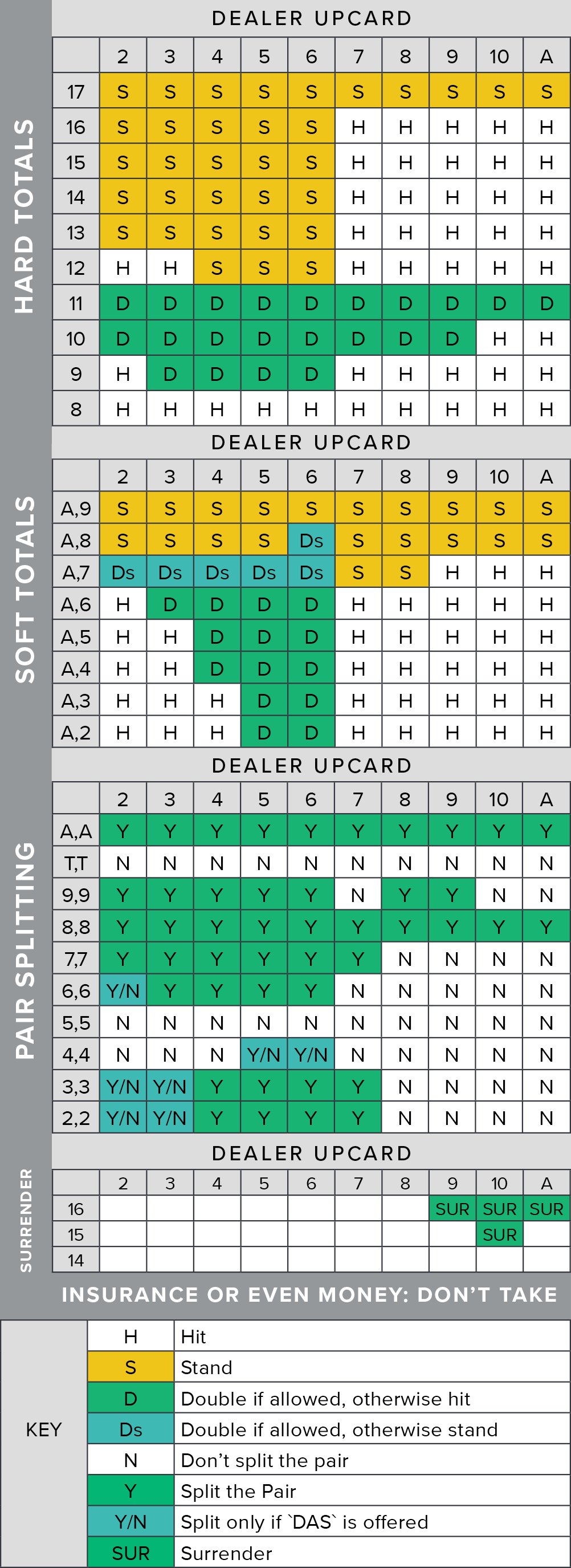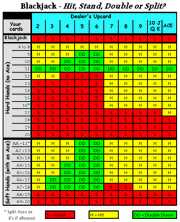Blackjack Hit Or Stand
A free blackjack game that teaches blackjack strategy while you play. There's a message board, a high score list, and a bonus round. The best decision here would be to hit again, as the majority of dealers stand on soft 17, so you are likely to lose if you stand. You can hit until you get 21 or get busted, and the best solution depends on the. Blackjack Strategy Chart 2020 – When to Hit & Stand Blackjack is the most popular casino table game of all drawing in countless numbers of hungry players both in the brick and mortar casino, and in online. Always stand on soft 19 and soft 20. Stand on soft 18 if the dealer shows 7 or 8. Hit all other soft hands! If the rules allow it, you should also Double Down as suggested by this table. (If you can't Double Down.
The entire game of blackjack is based around the two words “Hit me”. All of the strategy and logic in the game comes down to whether or not you want to get another card added on top of your first two cards. Remember, the goal of blackjack is to either make the dealer bust, hit 21 yourself, or have a higher number than the dealer ends up with.
Most of the variance in the game comes from the idea of hitting or standing when you either get another card dealt to you, at risk of busting, or stay where you are, and risk the dealer beating you. This is a complex decision making process, and it’s important to know how to approach it.
This page details all of the methods you can use to understand when to hit or stand, and at the end, you can find a chart explaining why. Let’s jump right into it with a discussion of the dealer’s up card and why that matters.
Knowing When To Hit Or Stand - The Dealer’s Up Card
Understanding the implications of the dealer’s up card is very important. Basically, you get to see one of the dealer’s cards, and that allows you to make some guesses as to what number they are at, and what their decision making process will be. The higher the dealer’s up card, the more likely the player is to want to hit, as a general rule. This is because, once again, the goal is to beat the dealer - to get the closest to 21 without going over. The card you see tells you a lot about the range of possibilities they could have. For example, if you see a 2, you know that their total is relatively low, and if you have a decent total, it could be correct to stand. That’s the basics of understanding a dealer’s up card, but there’s so much more to understand what the process is behind choosing to stand.
When To Stand In Blackjack
The basic idea of when you want to stand in blackjack is when you have a pretty good idea that your total is pretty close to 21, you don’t want to risk going over, and you want to put the onus on the dealer to beat your total. This tends to mean that you want to start seriously considering standing at around 17 total. The idea here is that, unless you can see an ace from the dealer, you’re fairly likely to have more than them at this point, given the amount of times cards that are worth more than 7 appear in the deck. If you have 19, you’re always standing, for example. You’re likely to bust if you hit, and it’s relatively hard to beat. The rules for this are fairly fluid so understand them well.
When To Hit In Blackjack

The basic idea behind when you want to hit in blackjack is twofold. First, you want to hit when you aren’t in much danger of going over or busting. Second, you want to hit when you need to beat a decent dealer total. This means that if you have a middling hand, let’s say 15, you’ll want to stand if the dealer’s face up card is fairly low, but hit if the dealer’s face up card is higher. This is because you can extrapolate the range of possible outcomes from the dealer’s face up card, and understand when you need to hit, and when you need to stand. There’s a lot of math that goes into this, but you can play by intuition as well. Remember, the goal of the game is to beat the dealer without going over - and that’s devilishly simple, but devilishly tricky as well.
Blackjack Hit Or Stand
When Does The Dealer Have To Hit In Blackjack
The basic rules that most dealers follow, across the board, are determined to their mathematical advantage over years of study and play. The dealer will always hit on anything below a 16 total. This is why, when you have a 17, you tend to consider staying - you have something fairly close to what they tend to stay at. This can get a little more complex when people start considering aces, which allow the concept of hard and soft 17s to enter the equation, but that’s mostly a discussion for a different page. Suffice to say, the basic rule they follow is that they will hit anything that is a 16 total or below.
When Does The Dealer Have To Stay In Blackjack
Dealers in blackjack follow strict rules - rules that are designed for them to play as optimally as possible against you. The basic idea behind most of them is to optimize their mathematical odds at victory. For this reason, almost all dealers will stand when their total is 17 or above. As before, aces throw a bit of a wrench into this equation, but there is a lot of grey area in Blackjack. The basic rule they follow is to stand on 17 because that puts the onus on you to beat a 17, which is pretty hard to do without going over.
Hit Or Stand Cheat Sheets
Here is a very basic legal blackjack hit or stand cheat sheet. Remember that the math changes depending on which type of blackjack you’re playing, so make sure you understand what’s going on in each variant you play.
| Your Hand | Up Card | |||||||||
| 2 | 3 | 4 | 5 | 6 | 7 | 8 | 9 | 10 | A | |
| <11 | Hit | Hit | Hit | Hit | Hit | Hit | Hit | Hit | Hit | Hit |
| 12 | Hit | Hit | Stand | Stand | Stand | Hit | Hit | Hit | Hit | Hit |
| 13 | Stand | Stand | Stand | Stand | Stand | Hit | Hit | Hit | Hit | Hit |
| 14 | Stand | Stand | Stand | Stand | Stand | Hit | Hit | Hit | Hit | Hit |
| 15 | Stand | Stand | Stand | Stand | Stand | Hit | Hit | Hit | Hit | Hit |
| 16 | Stand | Stand | Stand | Stand | Stand | Hit | Hit | Hit | Hit | Hit |
| 17-21 | Stand | Stand | Stand | Stand | Stand | Stand | Stand | Stand | Stand | Stand |
My mom taught me how to play blackjack when I was a little kid. The strategy she taught me addressed when you should hit or stand in blackjack in simple terms.
She taught me to stand if I had a total of 16 or higher, and to hit if I had a total of 15 or lower.
If you know anything about blackjack basic strategy at all, you’ll know that her strategic advice was off-base, to say the least.
In this post, I’ll answer the question, “When should you hit or stand in blackjack?” in some degree of detail. Keep reading below to learn a few blackjack tips.
What Does It Mean to Hit or Stand?

The two basic moves in blackjack are to hit or to stand, although you have some other options. You might think everyone knows that, but you’d be surprised. A friend of mine took a date to the casino not too long ago, and she asked him what she should do next.
Blackjack Hit Or Stand Strategy
When he told her to “stand,” she didn’t necessarily understand what that meant for the game. So, no, not everyone knows what it means to hit or to stand.
For those folks, here’s a quick explanation of blackjack and the moves you can make during the game.
- You get two cards, and so does the dealer. The dealer has one card face-up and one card face-down.
- The cards are worth points based on their ranking. The numeric cards are worth their number. So, the seven of spades is worth 7 points. The face cards (the jacks, queens, and kings) are each worth 10 points. An ace is worth 1 or 11 points, whichever works out better for the hand.
- Your total score is the point value of the cards added together.
The higher total wins the bet, but there’s a catch. If you get a total of 22 or higher, you bust, which is an automatic loss.
When you play your hand, your basic moves are simple. You can “hit,” which means to get another card. Or you can “stand,” which means to forego any other cards and let the dealer play their hand.
The Implications of Going Bust
Since the blackjack player goes first, it’s important to avoid busting your hand if you can. Once you bust, you lose your bet, even though the dealer hasn’t played her hand yet.
The higher your total, the higher the probability that the next card will bust your hand.
If you have a total of 10, for example, it’s impossible to bust. The highest value card you can get is 11, which would give you a total of 21—the best possible point total you could have.
If you have a total of 11, it’s still impossible to bust. The only card worth 11 can also count as 1, so you’d never stand on a total of 10 or 11.
With a total of 12, you now start having a possibility of going bust… Which cards will bust a total of 12? Any card that’s nine or lower will improve your total, but any card worth 10 is going to bust you.
How many cards are worth nine or less? You have the following cards which could help your hand, and there are four of each of them:
- Aces
- 2s
- 3s
- 4s
- 5s
- 6s
- 7s
- 8s
- 9s
That’s 36 cards that will help you. There are also 16 cards worth 10 points in the deck—the 10s, jacks, queens, and kings. Those will bust you.
16/52 is the same thing as 4/13, which is slightly less than 1/3. If a card is going to help you almost 2/3 of the time, it’s probably a good idea to take that card.
Some More Examples of Totals and Possible Bust Cards
Suppose you have a higher total, though. Let’s say you have a total of 16, for example.
How many cards will help you in this situation?
- Aces
- 2s
- 3s
- 4s
- 5s
That’s 20 cards out of 52 which will help you, which leaves 32 cards which will bust your hand.
A lot of people always stand on 16, even though mathematically, that’s not always the correct move.
If blackjack were as simple as calculating the probability of going bust, everyone would know which moves to make and when. You also need to account for the dealer’s face-up card.

The correct strategy with a total of 16 is to stand if the dealer is showing a card of six or lower, but you should hit if the dealer has a seven or higher showing. For this purpose, an ace is also considered a high card.
Yes, you’ll bust most of the time, but the dealer has a strong enough hand that you must be willing to risk this to get the best odds of winning. In fact, with every possible total, you must consider both your total and the dealer’s total when deciding whether to hit or stand.
Soft Hands vs. Hard Hands
Something else to consider when deciding whether to hit or stand is whether you have a hard total or a soft total. What’s the difference?
Remember how I explained that an ace counts as either 1 or 11 points? If you have a hand with an ace in it where you can count it as either without going bust, you have a soft hand.
If you must count the ace as 1 point to avoid busting, it’s a hard hand. You’ll hit more often with soft hands because you’ll have a lower probability of going bust.
Here’s an ExampleBlackjack Hit Or Stand Card
You have an ace and a two. That’s a soft total of 13. If you get a 10 or a nine, you can just count the ace as a one instead of an 11, and you now have a total of 13 or 12, respectively.
You Do Have Other Options
Hitting and standing aren’t the only options you have. You can also make the following moves in blackjack.
You can split. If you get two cards of the same ranking, like two aces or a couple of eights, you can split your hand. This means you put up an additional bet and start two hands instead of one. These two hands play out independently.
You can double. Doubling down is the same thing as hitting, but with two differences:
- You must double the size of your bet.
- You can’t take any more cards after the first one.
You can surrender. If you hate your chances, you can surrender, which means you only lose half your bet. But you also have no chance of winning.
More About Basic Strategy in Blackjack
If you want to know the move in every situation with the best potential outcome in the long run, you’ll want to memorize basic strategy. Basic strategy was generated by running millions of hands through a simulator and determining which moves had the best expectation.
Most people learn basic strategy using a chart or a table. A table usually has the dealer’s possible up-cards listed across the top. The player’s possible totals are listed along the left-hand side.
You cross-index what you have with what the dealer has, and the table tells you what to do. The tricky thing about basic strategy is that the correct moves vary a little bit based on the conditions of the game you’re playing.

For example, basic strategy for a single deck game might be different in some situations from an eight-deck game. You can find multiple basic strategy generators on the internet, but for most recreational players, I recommend just learning a single basic strategy and sticking with it.
The difference in expected value from one game to another doesn’t usually change much regarding the handful of basic strategy differences based on game conditions.
And if you’re not counting cards, you’re playing a game with a house edge. No matter how big or small that edge is, you’ll eventually lose all your money in the long run.
What difference does it make if you lose it slightly faster?

Conclusion
When should you hit or stand in blackjack? When basic strategy tells you to!
That’s the only correct answer to that question. I’ve tried to offer some examples of how that math works, but it’s more complicated than just looking at the probability of busting.
You also need to account for the dealer’s possible outcomes.
Please enable JavaScript to view the comments powered by Disqus.